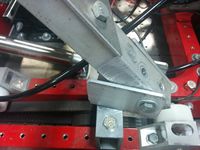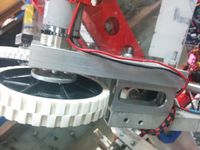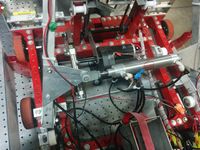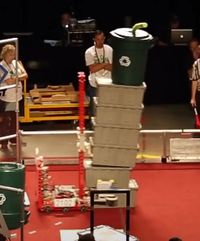Difference between revisions of "2015 Robot (Big Red)"
(→Fabrication Process) |
(→Mechanism Details) |
||
| (6 intermediate revisions by 2 users not shown) | |||
| Line 3: | Line 3: | ||
== Robot Overview == | == Robot Overview == | ||
The 2015 robot (Big Red) consisted mainly of one elevator as the workhorse mechanism standing (height) inches (-- feet) tall, lifting and stacking totes with the 'hook' on the carriage. The name came from it's very bright red powdercoating on all parts and because of how tall the elevator was, making it a large and unwieldy robot to move around. | The 2015 robot (Big Red) consisted mainly of one elevator as the workhorse mechanism standing (height) inches (-- feet) tall, lifting and stacking totes with the 'hook' on the carriage. The name came from it's very bright red powdercoating on all parts and because of how tall the elevator was, making it a large and unwieldy robot to move around. | ||
| + | |||
| + | '''Length:''' 29 1/8" | ||
| + | |||
| + | '''Width:''' 27" | ||
| + | |||
| + | '''Height:''' 77" | ||
| + | |||
| + | '''Weight:''' Unknown | ||
== Build Season == | == Build Season == | ||
| Line 16: | Line 24: | ||
=== Fabrication Process === | === Fabrication Process === | ||
| − | This robot design marked the start of Team Paradox's use of the common 2x1 aluminum extrusion as the basis for most of the chassis parts, and only included | + | This robot design marked the start of Team Paradox's use of the common 2x1 aluminum extrusion as the basis for most of the chassis parts, and only included a few wood pieces in the final design. Most chassis pieces were lined with #7 drilled holes every 1" to be tapped to 1/4"-20 and were cnc milled on the Tormach PCNC using CAMWorks, while some were easier done or finished on one of the manual mills as the swiss-cheesing could be done with a 1-1/8" end mill. The tapping was painstakingly done by a freshman on a drill press using an ancient drill press tapping head that made the undertaking much easier, but also led to some holes becoming stripped. |
=== Assembly Process === | === Assembly Process === | ||
| − | + | Since Big Red was made almost exclusively using 2x1 extrusion with 1/4"-20 holes every 1", Bubbles the welding table was incredibly useful during assembly [awk]. The elevator assembly had a very tight and compact base, and was assembled on Bubbles prior to inserting it into the chassis. The Entire chassia used 1/4"-20 bolts and nuts and was therefore very straightforward to assemble after the parts were all finished and powdercoated. [add info on powdercoating and bearing tolerances] | |
== Mechanism Details == | == Mechanism Details == | ||
=== Chassis and Drivetrain === | === Chassis and Drivetrain === | ||
| − | + | [[image:frc2102_2015_chassis.jpg|thumb|200px|Close-up of Big Red's chassis]] | |
| + | |||
| + | Big Red had a 6 wheel [[Drivetrains#Tank| west coast drive]], powered by two [[Motors#CIM| CIM]] motors run through a [https://www.vexrobotics.com/single-speed-double-reduction.html Vex single-speed double-reduction gearbox]. The wheels 4" diameter [https://www.vexrobotics.com/traction-wheels.html Vex Traction Wheels] with roughtop tread belt driven off of 15mm wide HTD 5mm timing belts. The belts were tensioned with an eccentric UHMW cylinder that could be rotated into position. | ||
| + | |||
| + | === Intake/Centering Arms === | ||
| + | In order to acquire and center totes and bins in the robot, Bid Red had two arms, roughly 24" long that pivoted from a point 14.5" back on the robot's chassis. They were actuated by a pneumatic cylinder that floated between the arms. For transport configuration, the arms could rotate upwards, but were simply held down by gravity for regular operation. At the end of each arm was an [[Motors#RS775| RS775]] motor with a 71:1 AndyMark [https://www.andymark.com/products/hex-pg-series-gearboxes-options PG series] gearbox, driving a 6" AndyMark [https://www.andymark.com/products/higrip-wheels-options?Diameter=6%20in.&quantity=1&Durometer=80A HiGrip] wheel. 3D printed covers were placed over the motors to protect the wires. | ||
| + | {| | ||
| + | |- | ||
| + | ! Detail: Arm Pivot !! Detail: Wheel and Motor !! Detail: Pneumatic Cylinder | ||
| + | |- | ||
| + | | [[image:FRC2102-2015-intakepivot.jpg|thumb|text-top|center|200px|]] || [[image:FRC2102-2015-intakewheel.jpg|thumb|text-top|center|200px|]] || [[image:FRC2102-2015-intakecylinder.jpg|thumb|text-top|center|200px|]] | ||
| + | |} | ||
| + | |||
| − | === | + | === Elevator === |
| − | ( | + | The elevator was a single-stage elevator powered by two CIMs running through a vex single-speed gearbox (same as the drivetrain) with an encoder. It had two vertical runs of number 25 chain to lift the carriage, and a total travel distance of approximately 60 inches. |
| − | === | + | === Carriage === |
| − | + | [[image:frc2102_2015_carriage.jpg|thumb|200px|The hook and support on Big Red's carriage]] | |
| + | The carriage was 11 1/2 inches tall, with four UHMW rollers on each bar, spaced at 10 1/4 inches apart. The carriage didn't require bearings along the sides because all of the load being taken was in the forward/backward direction, with no side-to-side loads being applied to the elevator. The large distance between rollers helped to carry the heavy load on the elevator, as a capped six stack was approximately 55 pounds. Bearings were not necessary for the carriage rollers, given the high loads and low speeds. | ||
| − | + | On the front of the carriage was a hook made out of a bent steel plate, with a brace extending below it to prevent totes from sagging forwards. | |
| − | |||
== Software == | == Software == | ||
| Line 39: | Line 59: | ||
=== By The Numbers === | === By The Numbers === | ||
==== Rating Metrics ==== | ==== Rating Metrics ==== | ||
| − | OPR: | + | Main Article: [[Rating Metrics]] |
| + | |||
| + | '''OPR:''' | ||
| + | <br>Central Valley Regional: 25.6 (11th of 49 teams competing) | ||
| + | <br>San Diego Regional: 51.2 (4th of 59 teams competing) | ||
| + | |||
| + | '''Elo:''' | ||
| + | <br>1642 (217th of 2872 teams competing) | ||
| − | |||
==== Competition Results ==== | ==== Competition Results ==== | ||
{| class="wikitable" | {| class="wikitable" | ||
|- | |- | ||
| − | ! Event !! | + | ! Event !! Average Qual Score !! Rank !! Alliance Selection !! Playoffs Record !! Awards |
|- | |- | ||
| − | | [http://thebluealliance.com/event/ | + | | [http://thebluealliance.com/event/2015cama Central Valley Regional] || 66.0 || 5th of 49 || 1st pick onto Alliance 2 by Team 701|| Finalist || Dean's List Finalist (Kylah C)<br>Judges' Award |
|- | |- | ||
| − | | [http://thebluealliance.com/event/ | + | | [http://thebluealliance.com/event/2015casd San Diego Regional] || 88.0 || 4th of 59 || 3rd Alliance captain with 2485 and 1266 || Semifinalist || Woodie Flowers Finalist (John Gaby)<br>Quality Award |
| − | |||
| − | |||
|} | |} | ||
| + | |||
=== Successes (Plusses) === | === Successes (Plusses) === | ||
| − | ( | + | Big Red was the most competitive robot that 2102 had ever built at the time, and was the highest elo robot until [[2019_Robot_(Flip)|2019's Flip]]. The simple but effective design made for a robot that never once broke down at competition, working reliably through both events. CVR 2015 was 2102's third ever appearance in the finals, and a loss to the 254/1678 alliance hardly constitutes failure. At San Diego, 2102, 2485, and 1266 set the event high score of 206 points. Packaging the electronics on a vertical panel made them secure but easily accessible, and the robust carriage design was very hard to damage. |
=== Failures (Deltas) === | === Failures (Deltas) === | ||
| − | + | [[image:frc2102_2015_sixstack.jpg|thumb|200px|Big Red at the San Diego Regional]] | |
| + | Strategically, Big Red lacked a [[2015_FRC_Season#Can_Grabbers|can grabber]] which left it at a disadvantage in higher level play. Big Red also lacked a method of stabilizing large stacks, and relied on careful driving to safely transport stacks of more than 4. To move a six stack, the driver had to use the carriage to carry the weight of the top four totes while the robot and intake pushed the bottom two, as seen in the screenshot to the right. After competition ended, Big Red was used as an outreach robot. A design flaw eventually surfaced in that the drive shafts were constrained by a press fit bearing in the gearboxes, which eventually worked its way out, causing axles to fall out while driving. | ||
=== Lessons Learned === | === Lessons Learned === | ||
| − | + | * Simplicity and reliability are more important than a rich feature set. | |
| + | * Serviceable electronics make life easier. | ||
| + | * A more in-depth strategic analysis may have highlighted the need for a can grabber. | ||
| + | * Earlier prototyping and drive testing may have highlighted the need for a stack stabilizer. | ||
== References == | == References == | ||
[[List of Team Paradox Robots]] | [[List of Team Paradox Robots]] | ||
Latest revision as of 13:05, 27 August 2020
Robot Overview[edit]
The 2015 robot (Big Red) consisted mainly of one elevator as the workhorse mechanism standing (height) inches (-- feet) tall, lifting and stacking totes with the 'hook' on the carriage. The name came from it's very bright red powdercoating on all parts and because of how tall the elevator was, making it a large and unwieldy robot to move around.
Length: 29 1/8"
Width: 27"
Height: 77"
Weight: Unknown
Build Season[edit]
Main Article: 2015 FRC Season
Main Article: Team Paradox in 2015
Strategy[edit]
(What strategic analysis led to this design.)
Prototyping and Design Process[edit]
(What designs were investigated, pictures and videos of prototypes welcome. Linking to google photos okay.)
Fabrication Process[edit]
This robot design marked the start of Team Paradox's use of the common 2x1 aluminum extrusion as the basis for most of the chassis parts, and only included a few wood pieces in the final design. Most chassis pieces were lined with #7 drilled holes every 1" to be tapped to 1/4"-20 and were cnc milled on the Tormach PCNC using CAMWorks, while some were easier done or finished on one of the manual mills as the swiss-cheesing could be done with a 1-1/8" end mill. The tapping was painstakingly done by a freshman on a drill press using an ancient drill press tapping head that made the undertaking much easier, but also led to some holes becoming stripped.
Assembly Process[edit]
Since Big Red was made almost exclusively using 2x1 extrusion with 1/4"-20 holes every 1", Bubbles the welding table was incredibly useful during assembly [awk]. The elevator assembly had a very tight and compact base, and was assembled on Bubbles prior to inserting it into the chassis. The Entire chassia used 1/4"-20 bolts and nuts and was therefore very straightforward to assemble after the parts were all finished and powdercoated. [add info on powdercoating and bearing tolerances]
Mechanism Details[edit]
Chassis and Drivetrain[edit]
Big Red had a 6 wheel west coast drive, powered by two CIM motors run through a Vex single-speed double-reduction gearbox. The wheels 4" diameter Vex Traction Wheels with roughtop tread belt driven off of 15mm wide HTD 5mm timing belts. The belts were tensioned with an eccentric UHMW cylinder that could be rotated into position.
Intake/Centering Arms[edit]
In order to acquire and center totes and bins in the robot, Bid Red had two arms, roughly 24" long that pivoted from a point 14.5" back on the robot's chassis. They were actuated by a pneumatic cylinder that floated between the arms. For transport configuration, the arms could rotate upwards, but were simply held down by gravity for regular operation. At the end of each arm was an RS775 motor with a 71:1 AndyMark PG series gearbox, driving a 6" AndyMark HiGrip wheel. 3D printed covers were placed over the motors to protect the wires.
| Detail: Arm Pivot | Detail: Wheel and Motor | Detail: Pneumatic Cylinder |
|---|---|---|
Elevator[edit]
The elevator was a single-stage elevator powered by two CIMs running through a vex single-speed gearbox (same as the drivetrain) with an encoder. It had two vertical runs of number 25 chain to lift the carriage, and a total travel distance of approximately 60 inches.
Carriage[edit]
The carriage was 11 1/2 inches tall, with four UHMW rollers on each bar, spaced at 10 1/4 inches apart. The carriage didn't require bearings along the sides because all of the load being taken was in the forward/backward direction, with no side-to-side loads being applied to the elevator. The large distance between rollers helped to carry the heavy load on the elevator, as a capped six stack was approximately 55 pounds. Bearings were not necessary for the carriage rollers, given the high loads and low speeds.
On the front of the carriage was a hook made out of a bent steel plate, with a brace extending below it to prevent totes from sagging forwards.
Software[edit]
Performance[edit]
By The Numbers[edit]
Rating Metrics[edit]
Main Article: Rating Metrics
OPR:
Central Valley Regional: 25.6 (11th of 49 teams competing)
San Diego Regional: 51.2 (4th of 59 teams competing)
Elo:
1642 (217th of 2872 teams competing)
Competition Results[edit]
| Event | Average Qual Score | Rank | Alliance Selection | Playoffs Record | Awards |
|---|---|---|---|---|---|
| Central Valley Regional | 66.0 | 5th of 49 | 1st pick onto Alliance 2 by Team 701 | Finalist | Dean's List Finalist (Kylah C) Judges' Award |
| San Diego Regional | 88.0 | 4th of 59 | 3rd Alliance captain with 2485 and 1266 | Semifinalist | Woodie Flowers Finalist (John Gaby) Quality Award |
Successes (Plusses)[edit]
Big Red was the most competitive robot that 2102 had ever built at the time, and was the highest elo robot until 2019's Flip. The simple but effective design made for a robot that never once broke down at competition, working reliably through both events. CVR 2015 was 2102's third ever appearance in the finals, and a loss to the 254/1678 alliance hardly constitutes failure. At San Diego, 2102, 2485, and 1266 set the event high score of 206 points. Packaging the electronics on a vertical panel made them secure but easily accessible, and the robust carriage design was very hard to damage.
Failures (Deltas)[edit]
Strategically, Big Red lacked a can grabber which left it at a disadvantage in higher level play. Big Red also lacked a method of stabilizing large stacks, and relied on careful driving to safely transport stacks of more than 4. To move a six stack, the driver had to use the carriage to carry the weight of the top four totes while the robot and intake pushed the bottom two, as seen in the screenshot to the right. After competition ended, Big Red was used as an outreach robot. A design flaw eventually surfaced in that the drive shafts were constrained by a press fit bearing in the gearboxes, which eventually worked its way out, causing axles to fall out while driving.
Lessons Learned[edit]
- Simplicity and reliability are more important than a rich feature set.
- Serviceable electronics make life easier.
- A more in-depth strategic analysis may have highlighted the need for a can grabber.
- Earlier prototyping and drive testing may have highlighted the need for a stack stabilizer.






